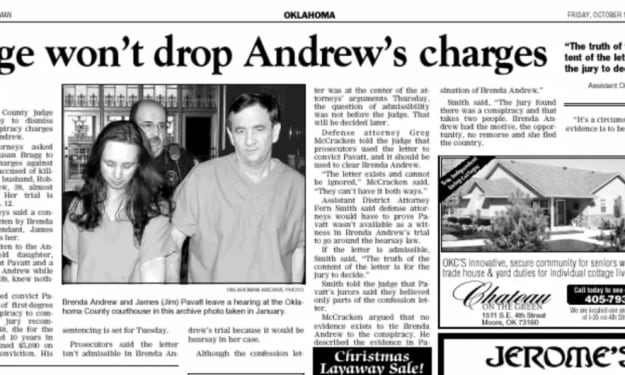Dennis Nilsen: The Gruesome Tale of a Serial Killer's Reign of Terror
Unmasking the Chilling Crimes of a Twisted Mind, 15 Lives Lost in Silence

On December 1, 2021, the chilling story of Dennis Nilsen, a British serial killer, came to light once again. Between December 1978 and February 1983, Nilsen brutally murdered 15 young men, practically under the noses of his neighbors. When he was finally apprehended, the police realized that his killing spree could have been stopped much earlier. Some fortunate men who managed to escape his clutches had already reported Nilsen to the authorities, but unfortunately, no one took their claims seriously.
Background:
Dennis Nilsen was born on November 23, 1945, in Fraserburgh, Scotland. His parents' marriage was unhappy, and he ended up living with his mother and siblings at his maternal grandfather's house. Nilsen later claimed that the unexpected death of his beloved grandfather and the traumatic experience of viewing his corpse at the funeral contributed to his later behavioral psychopathology.
His mother remarried and had four more children, which led to Nilsen receiving less attention and becoming withdrawn. He kept his homosexuality a secret. At the age of sixteen, he joined the army and became a cook, acquiring skills that would prove useful during his killing spree. After leaving the army in 1972, he started training to become a police officer but eventually switched to a career in personnel management.
The Murders:
In 1973, Nilsen was accused of secretly photographing a sleeping young man, but the charges were dropped. Over time, his feelings of loneliness intensified with each meaningless sexual encounter. On December 29, 1978, he met his first young victim at a pub and invited him home, as he had done on previous occasions. The next morning, overwhelmed by the desire to prevent the man from leaving, he strangled him with a tie and then drowned him in a bucket of water. Nilsen washed the body in his bathroom, returned it to his bed, and realized that the lifeless corpse sexually aroused him. He hid the body under the floorboards for seven months before burning the decomposed remains in his backyard.
In October 1979, another young man reported Nilsen to the police, stating that he had tried to strangle him during a bondage game. Once again, no charges were brought against Nilsen.
On December 3, 1979, Nilsen encountered his second victim, a Canadian tourist named Kenneth Ockendon, in a pub. They went sightseeing, got drunk, and the evening ended at Nilsen's apartment. Driven by the fear of being abandoned, he strangled the young man with an electrical cable. Again, the lifeless body lay next to him for a night. Nilsen took photos and desecrated the body. Even after hiding Ockendon's remains under the floorboards, he continued to have conversations with the corpse, pretending it was still alive.
The Next Victims: Martyn Duffey and Billy Sutzar:
By 1981, Nilsen had killed twelve men in his apartment in a similar manner. The four mentioned victims are the only ones that could be identified, mainly because many of Nilsen's victims were homeless, making further identification challenging in the anonymity of a big city.
Nilsen later claimed that he entered a "murder trance," but in seven instances, he managed to escape from it and released the men instead of killing them. At one point, he ran out of space to hide the bodies; up to six corpses were concealed in his apartment simultaneously. He had to use air fresheners daily to combat the smell of decomposing bodies. Despite neighbors complaining about the foul odor, Nilsen convinced them that it was due to structural issues.
In a desperate attempt to get rid of the bodies, he dismembered them on his stone kitchen floor. Some parts were buried, while others were discarded in the trash or burned. Even with fires in the courtyard, none of his neighbors grew suspicious. During later forensic examinations, the police found thousands of bone fragments in the garden.
In 1982, attempting to suppress his murderous impulses, Nilsen moved to an apartment on the top floor at 23 Cranley Gardens, Muswell Hill, also in North London, this time without a garden. Still unable to control his urges, he killed three more men in the apartment between his move and February 1983. Disposal became a real challenge. Many human remains ended up in the toilet and the trash, which ultimately led to his downfall.
In early February 1983, one of the other tenants reported a blockage in the drains. Maintenance work uncovered human remains, leading to a police investigation. On the morning of February 9, 1983, Nilsen reportedly told a colleague with a smile, "If I'm not here tomorrow, I'm either sick, dead, or in prison."
Investigation and Trial:
Detective Jay entered Nilsen's apartment that morning and noticed an unpleasant smell. Nilsen then presented him with two heads and other body parts stored in bags. He immediately confessed to murdering 15 men and attempting to murder seven others. Despite showing no remorse, Nilsen was eager to reveal all the details of his crimes to investigators. He filled over 50 notebooks with sketches and other information about the murders.
Nilsen pleaded not guilty, presenting attestations from two psychologists who diagnosed him with a disturbed psyche. However, due to overwhelming evidence, he was found guilty of six proven murders and received a life sentence with no chance of parole for at least 25 years.
Dennis Nilsen died on May 12, 2018, at the age of 72, due to a burst aortic aneurysm. He remained incarcerated until his death.
About the Creator
Emma
I'm a passionate storyteller.With every word I put to paper, I aim to evoke emotions, stimulate thoughts, and take readers on a journey they won't soon forget. Stories have the power to connect people and offer them an escape from reality
Enjoyed the story? Support the Creator.
Subscribe for free to receive all their stories in your feed. You could also pledge your support or give them a one-off tip, letting them know you appreciate their work.






Comments
There are no comments for this story
Be the first to respond and start the conversation.